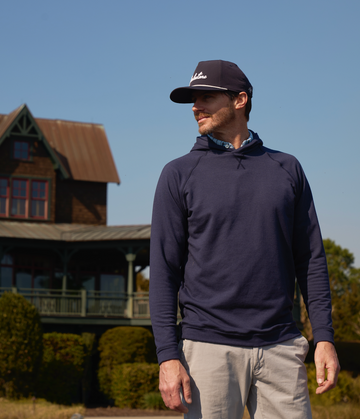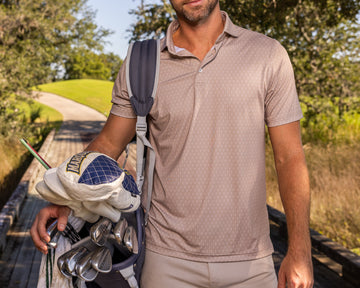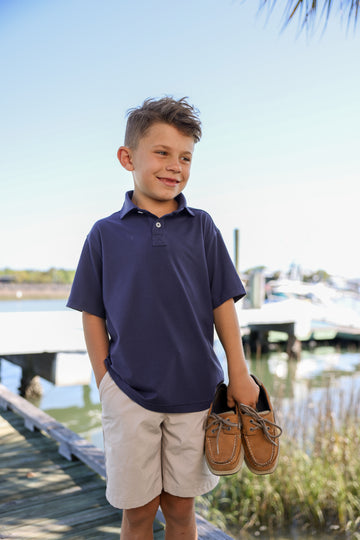As the days grow shorter and the air crisper, avid golfers aren’t packing away their clubs—they’re gearing up for the cooler months. Fall and winter rounds can be some of the most enjoyable of the year, offering beautiful landscapes and quieter courses. But these chilly tee times require a shift in wardrobe to keep you warm, comfortable, and playing at your best.
If you're wondering how to adjust your golf apparel for fall and winter, you’ve come to the right place. In this guide, we’ll break down essential cold-weather golf gear that ensures you’ll be ready to play no matter the temperature. From selecting the best golf jackets to finding the right fall golf outfits, we'll help you stay stylish and warm. Let’s dive in.
Why You Shouldn't Stop Golfing in Cold Weather
Golf in cold weather might sound daunting, but it can offer some of the most serene and peaceful rounds of the year. The course is quieter, the autumn scenery is spectacular, and the experience is just different enough to reinvigorate your love for the game. But to truly enjoy golf in colder conditions, preparation is key. Without the right gear, the experience can quickly go from enjoyable to uncomfortable.
That’s where strategic layering and weatherproof clothing come into play. You don't want to wear anything too bulky that restricts your swing, but you'll still need proper coverage to shield yourself from the elements.
The Importance of Layering for Fall and Winter Golf
When golfing in cooler weather, the most crucial tactic is layering. Layering allows you to add or remove clothing depending on how the temperature changes during your round. It’s common for temperatures to shift dramatically between your early morning tee-off and your back nine. Layering provides flexibility, but each layer needs to serve a purpose—be it for warmth, moisture management, or wind protection.
Start with a Moisture-Wicking Base Layer
The base layer is the first and most important layer you put on because it directly touches your skin. Look for moisture-wicking materials like polyester blends or merino wool, which are designed to keep sweat off your skin, regulate your temperature, and keep you comfortable. Even in cold weather, you'll sweat during a round of golf, and a base layer that doesn't dry quickly can leave you feeling chilled.
Pro tip: Opt for a long-sleeve base layer for full arm coverage without adding unnecessary bulk.
Mid-Layer: The Insulation Layer
Once you’ve got your base layer in place, it’s time for the mid-layer. This layer is all about warmth and insulation. The best mid-layers will trap heat while remaining breathable, so you don't overheat when you're moving between shots.
A quarter-zip sweater or a lightweight fleece is ideal for fall golf, as it offers warmth without hindering your range of motion. For winter golf, consider a more substantial mid-layer, like a padded vest or a hybrid jacket that provides both insulation and mobility.
Top Layer: Weatherproof Jackets
Your outermost layer is your defense against wind, rain, and snow, making it a key piece in any fall or winter golf wardrobe. Look for the best golf jackets that offer a combination of wind resistance, water resistance, and breathability.
One highly recommended option is a windproof jacket with water-repellent properties. A good golf jacket will also have stretch panels or articulated arms to ensure you can swing freely without feeling restricted. For wetter days, consider a packable waterproof jacket that you can easily stash in your golf bag when the rain clears up.
Pants for Cooler Rounds: Comfort Meets Functionality
When the temperature drops, your usual golf pants might not be enough. Opt for thermal golf pants or those made from thicker, wind-resistant fabrics. Many brands now offer pants with water-resistant coatings, keeping moisture from damp grass or rain off your skin.
If you’re playing in near-freezing temperatures, consider wearing thermal leggings or compression tights under your pants for an extra layer of warmth.
Cold Weather Golf Accessories: Don’t Forget the Details
Accessories are often overlooked, but they can make a big difference when golfing in cold weather. Here are a few must-haves:
- Golf Beanie: Keeping your head warm is crucial. A wool or thermal beanie will keep your body heat from escaping.
- Winter Golf Gloves: Cold hands can ruin your grip and make it harder to control the club. Winter golf gloves are thicker and insulated to keep your hands warm while still allowing you to maintain a firm hold.
- Neck Gaiter or Scarf: A fleece-lined neck gaiter provides warmth without the bulk of a scarf, keeping cold air from slipping down your collar.
Footwear: Waterproof and Insulated Golf Shoes
Cold, wet feet are a surefire way to make a round miserable. That’s why investing in waterproof golf shoes is a must. Many brands offer insulated golf shoes designed specifically for cooler conditions, providing both warmth and weatherproofing.
If your current golf shoes are comfortable but not warm enough, thermal insoles or merino wool socks are an affordable solution to keep your feet warm and dry. Just be sure your socks are thick enough to insulate but not so bulky that they make your shoes feel too tight.
Fall and Winter Golf Outfit Inspiration
Now that we've covered the essentials, let’s pull it all together. Here are some fall and winter golf outfits that balance style and function:
- Classic Layered Look: Start with a long-sleeve base layer, add a lightweight pullover or fleece, and top it off with a windproof jacket. Pair with thermal golf pants and waterproof shoes for the ultimate all-weather outfit.
- Casual Cold Weather Comfort: For a more relaxed look, pair a thermal vest with a mock neck sweater and a beanie. Add slim-fit, insulated pants for a sleek silhouette that still keeps you warm.
- Sophisticated Winter Golf Style: Go for a muted color palette with a high-quality wool sweater layered under a tailored waterproof jacket. Combine this with dark thermal trousers and winter golf gloves for a polished, modern look on the course.
How to Care for Your Cold Weather Golf Gear
To get the most out of your cold-weather golf gear, proper care is essential. Make sure to wash moisture-wicking and waterproof clothing with care, following the manufacturer’s instructions to maintain the fabric's technical properties.
Waterproof jackets should be reproofed with a water-repellent spray after several washes to ensure they continue to perform well in wet conditions. Regularly check your golf shoes for any signs of wear and tear, especially on the soles and seams, and replace them when necessary to maintain their waterproof properties.
Conclusion
Golfing in the colder months can be a rewarding experience, but only if you’re dressed for it. By selecting the right gear—whether it’s a golf jacket designed for wind resistance or the perfect fall golf outfit—you’ll stay comfortable and focused on your game. Remember, layering is key, and don’t forget those all-important accessories like gloves and hats.
With the right combination of cold weather golf gear, you’ll be able to enjoy the course year-round, no matter how chilly it gets.
Golf Gear for the Cooler Months: What to Wear for Fall and Winter Rounds












